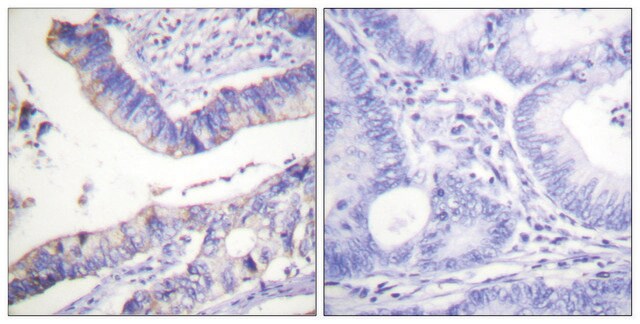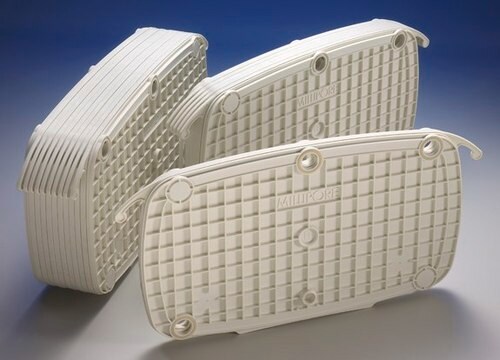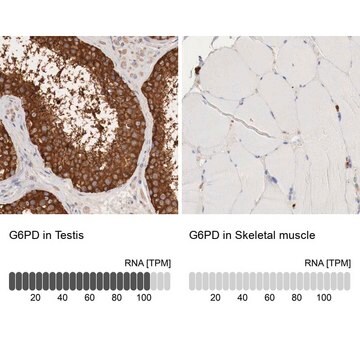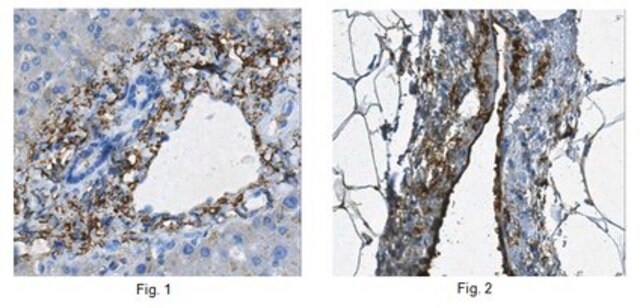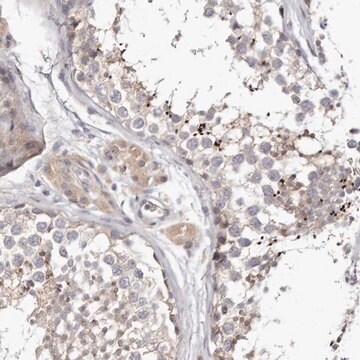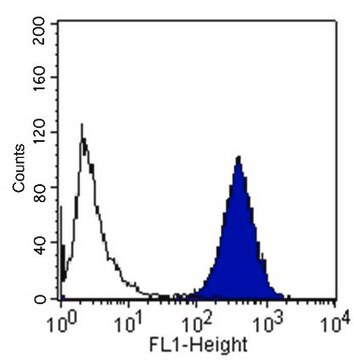おすすめの製品
由来生物
rat
品質水準
結合体
unconjugated
抗体製品の状態
purified antibody
抗体製品タイプ
primary antibodies
クローン
B6A6, monoclonal
精製方法
using protein G
化学種の反応性
mouse
包装
antibody small pack of 100 μg
テクニック
flow cytometry: suitable
immunohistochemistry (formalin-fixed, paraffin-embedded sections): suitable
アイソタイプ
IgG2aκ
エピトープ配列
Unknown
タンパク質IDアクセッション番号
UniProtアクセッション番号
輸送温度
ambient
ターゲットの翻訳後修飾
unmodified
詳細
The small intestine consists of continuous villi and crypts. The crypt is mainly a proliferative compartment and is maintained by multipotent stem cells whereas the villus represents the differentiated compartment, and it receives cells from multiple crypts. The functional compartment of the epithelium contains differentiated cells that populate the villi and can be categorized based on their function: enterocytes that function to absorb nutrients, goblet cells that secrete a protective mucus barrier, and enteroendocrine cells that release gastrointestinal hormones. Intestinal crypts contain intestinal stem cells (ISC), which are multipotent adult stem cells that reside in the base of crypts. They continuously self-renew by dividing and differentiate into the specialized cells of the intestinal epithelium, which renews throughout life. ISCs located either at the crypt base interspersed between the Paneth cells can be categorized into active-cycling (Lgr5+ cells) or those located near the þ4 position in the crypt as slow-cycling Bmi-1+ cells. Paneth cells that are responsible for secreting antibacterial peptides reside at the base of the proliferative compartment. As ISCs begin to differentiate, they migrate toward the lumen and are eventually shed, either from the tip of the intestinal villi or from the surface of the colonic epithelium. Villus represents the differentiated compartment of intestinal cells. Clone B6A6 recognizes most villous cells except goblet cells. (Ref.: Smith, NR., et al. (2018). Cell. Mol. Gastroenterol. Hepatol. 6(1);79-96; Wang, F., et al. (2013). Gastroenterology. 145(2); 383-395; Umar, S. (2010). Curr. Gastroenterol. Rep. 12(5); 340-348).
特異性
Clone B6A6 is a rat monoclonal antibody that detects intestinal villus cells.
免疫原
Undifferentiated Mouse intestinal epithelial cells. Rats were preimmunized with isolations of differentiated mouse intestinal epithelial cells and then treated with cyclophosphamide (i.p.) to eliminate B lymphocytes reacting against these antigens. Subsequent immunization was with crypt-based single cells.
アプリケーション
Quality Control Testing
Isotype testing: Identity Confirmation by Isotyping Test.
Isotyping Analysis: The identity of this monoclonal antibody is confirmed by isotyping test to be mouse IgG2a .
Tested Applications
Flow Cytometry Analysis: A representative lot detected Intestinal Villus in Lgr5-GFP mouse intestinal cells ( Data courtesy of Prof. Melissa Wong, Ph.D., Oregon Health & Science University, Portland, Oregon USA).
Immunohistochemistry Applications: A representative lot detected Intestinal Villus cells in Immunohistochemistry applications (Wang, F., et al. (2013). Gastroenterology. 145(2): 383-95.e1-21).
Flow Cytometry Analysis: A representative lot detected Intestinal Villus in Flow Cytometry applications (Wang, F., et al. (2013). Gastroenterology. 145(2): 383-95.e1-21; Smith, N.R., et al. (2017). Cell Mol Gastroenterol Hepatol. 3(3): 389-409; Yan, K.S., et al. (2017). Cell Stem Cell. 21(1):7 8-90.e6; Smith, N.R., et al. (2018). Cell Mol Gastroenterol Hepatol. 6(1): 79-96).
Note: Actual optimal working dilutions must be determined by end user as specimens, and experimental conditions may vary with the end user
Isotype testing: Identity Confirmation by Isotyping Test.
Isotyping Analysis: The identity of this monoclonal antibody is confirmed by isotyping test to be mouse IgG2a .
Tested Applications
Flow Cytometry Analysis: A representative lot detected Intestinal Villus in Lgr5-GFP mouse intestinal cells ( Data courtesy of Prof. Melissa Wong, Ph.D., Oregon Health & Science University, Portland, Oregon USA).
Immunohistochemistry Applications: A representative lot detected Intestinal Villus cells in Immunohistochemistry applications (Wang, F., et al. (2013). Gastroenterology. 145(2): 383-95.e1-21).
Flow Cytometry Analysis: A representative lot detected Intestinal Villus in Flow Cytometry applications (Wang, F., et al. (2013). Gastroenterology. 145(2): 383-95.e1-21; Smith, N.R., et al. (2017). Cell Mol Gastroenterol Hepatol. 3(3): 389-409; Yan, K.S., et al. (2017). Cell Stem Cell. 21(1):7 8-90.e6; Smith, N.R., et al. (2018). Cell Mol Gastroenterol Hepatol. 6(1): 79-96).
Note: Actual optimal working dilutions must be determined by end user as specimens, and experimental conditions may vary with the end user
Anti-Intestinal Villus clone B6A6, Cat. No. MABS2233, is a rat monoclonal antibody that detects Intestinal Villus cells and is tested for use in and Flow Cytometry and Immunohistochemistry.
物理的形状
Purified rat monoclonal antibody IgG2a in buffer containing 0.1 M Tris-Glycine (pH 7.4), 150 mM NaCl with 0.05% sodium azide.
保管および安定性
Recommended storage: +2°C to +8°C.
その他情報
Concentration: Please refer to the Certificate of Analysis for the lot-specific concentration.
免責事項
Unless otherwise stated in our catalog or other company documentation accompanying the product(s), our products are intended for research use only and are not to be used for any other purpose, which includes but is not limited to, unauthorized commercial uses, in vitro diagnostic uses, ex vivo or in vivo therapeutic uses or any type of consumption or application to humans or animals.
適切な製品が見つかりませんか。
製品選択ツール.をお試しください
保管分類コード
12 - Non Combustible Liquids
WGK
WGK 1
適用法令
試験研究用途を考慮した関連法令を主に挙げております。化学物質以外については、一部の情報のみ提供しています。 製品を安全かつ合法的に使用することは、使用者の義務です。最新情報により修正される場合があります。WEBの反映には時間を要することがあるため、適宜SDSをご参照ください。
Jan Code
MABS2233-100UG:
MABS2233-25UG:
試験成績書(COA)
製品のロット番号・バッチ番号を入力して、試験成績書(COA) を検索できます。ロット番号・バッチ番号は、製品ラベルに「Lot」または「Batch」に続いて記載されています。
ライフサイエンス、有機合成、材料科学、クロマトグラフィー、分析など、あらゆる分野の研究に経験のあるメンバーがおります。.
製品に関するお問い合わせはこちら(テクニカルサービス)
